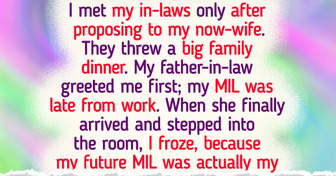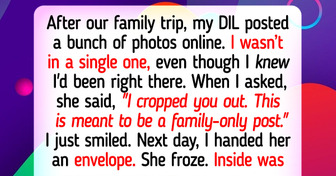My Husband Made Me Care for His Sick Mother, So I Served a Payback He Won’t Forget


People come up with the craziest ideas, don’t they? I mean, candies on a stick? How did we even get there, and why? And how about the name “lollipop”? Let’s look at some of the history and facts of the popular treat.

Ok, it wasn’t called a lollipop, to begin with. We’ll get to that name a bit later. But the initial lollipop-like sweet treat was most likely “invented” by people that roamed the Earth thousands of years ago while still living in caves, no less!
We know that they enjoyed honey and used a stick to collect it from beehives. Remember, this was way back when people had very few resources when it came to food or anything else for that matter. So since they did not want anything to go to waste, they probably ended up licking the stick to make sure they ate every single drop of the nectar.
Ancient Egyptians also had a “lollipop” of their own. They took various fruits and nuts and glazed them in honey. Sure, it made the food taste better, but it also helped with preserving it for longer. Since it has such a high concentration of sugar, honey pushes the water out of any harmful cells that could damage the food and make it go bad faster. To avoid those sticky honey fingers, they used a stick for eating these treats, too.

Let’s fast-forward to the 1600s when sugar became far more available to the general public. We know now that the English loved boiled sugar candy treats, and they popped those in the sticks, making them easier to enjoy. It’s probably during this time when we came up with the term lollipop, as linguists believe it basically translates to ‘tongue slap’. How come? Well, for the word ‘tongue,’ they often use the word ‘lolly’ in Northern England. And ‘pop’ means ‘slap.’
The “lollipop” timeline now takes us to 1912, when a man named Samuel Born actually invented a device that inserted sticks into candy. It became so popular that Samuel was awarded the keys to the City of San Francisco in 1916!
However, it was a man named George Smith, who owned a confectionery company that took credit for inventing the version of the lollipop which we’ve come to know and love to this day, back in 1908. He even trademarked the name in 1931. He claimed the name for the treat came from a famous racehorse named Lolly Pop.

As you can probably tell by now, there is still some competition regarding this name, but what we do know for sure is that the lollipop became more and more popular and has remained such ever since. I mean, some modern companies are capable of producing up to 3,000,000 of these candies per day, and the numbers are continuously growing.
The largest lollipop ever created goes back to 2012, when a Californian candy manufacturer made a staggering chocolate-flavored one. It weighed more than 7,000 pounds and stood proud at nearly 5 feet tall. If we take the stick into consideration, too, this huge lollipop was over 11 feet tall.
One of the most famous lollipop brands in the world is Chupa Chups. Did you know this brand’s logo has a very famous name behind it? It was that of none other than Salvador Dalí himself, the famous surrealist artist. The company approached him in 1969 to design the logo, and he came up with the distinguishing design that we know and love which has the Chupa Chups name incorporated into a brightly colored daisy shape.

The famous painter also came up with the idea that the logo should be placed on top of the candy instead of on the side. Why? So that you could always see it perfectly, without any of the wrinkles that are often associated with candy packaging. Smart, right? More so, this brand is also associated with candies we enjoy in the most uncommon places.
The story goes that a Chupa Chups was the first lollipop to be eaten in space! That was back in 1995, when an astronaut brought a Chupa Chups to the space station, officially making it the first lollipop to be consumed in a zero-gravity environment. Hmm, I wonder if it tasted any different... There’s a Chupa Chups under the sea, too, but it’s not actually what you think. It’s not the easiest thing in the world to enjoy a lolly underwater, right?
But, as they were advancing into an expedition to the Wardell Sea in the Antarctic Ocean back in 2000, a group of scientists stumbled upon a weird-looking sea sponge. It had a round-shaped head and was surprisingly similar to a lollipop. Obviously, it was given an appropriate name [Stylocordyla Chupachups]. The short version was S. Chupachups. If you ever search for pictures of these creatures, they look like underwater lollipops scattered on the bottom of the seabed.

While we’re on the subject of shape, ever wondered why lollipop sticks have that square hole featured in the plastic design? It actually has to do with the manufacturing process. When produced, the candy is melted into the stick. This ensures that the head of the lollipop stays firmly attached to its corresponding stick, so it doesn’t come loose and end up falling off. Ooh, what a pity!
Another reason is more of a safety feature, so the lollipop stick doesn’t become a choking hazard if swallowed by accident. Since it does allow air to go through, there’s still some breathing room should it ever get stuck somewhere... unfortunate. These days, the company Tootsie Roll has become the largest manufacturer of lollipops. They make over 16 million candies each and every day!
As for the Dum Dum lollipops, they got their names from their inventor. He wanted a name that was easy to pronounce and remember by the younger generation, the main demographic for the product. How about the Dum Dum mystery flavor? Is it actually that mysterious?
Nah, it’s actually a pretty straightforward recipe. They make it when one flavor batch is running out, and the next one is beginning, so the flavor comes out of random combinations of two different tastes, whatever they may be. But what does the famous writer Charles Dickens have to do with the lollipop? Well, it turns out that in the modern world, this name first appeared in one of his novels. This was back in the 1800s!

Lollipops aren’t all fun and games. Some of them are even used to cure people! They are especially handy for young ones who find it difficult to deal with traditional versions. But some of those lollipops are strictly for adults.
If you’re a big fan of this sweet treat, you might want to prepare for a nice celebration on the 20th of July each year. That’s when people in America celebrate National Lollipop Day! It’s common for people to give each other lollies during this day. Some stores also launch unique lines for this occasion and also put their best products on display.
The lollipop has some neat world records attached to it, too. Like the longest chain of people licking lollipops, which featured a mind-boggling 12,831 individuals. They put the event together in Valladolid, Spain, back in September 2008.

And for people looking for something fancier, you should know that the world’s most expensive lollipop comes with a hefty price of over $10,000! It’s not one single lollipop per se, but a chair made with 60 pounds worth of confectioner’s sugar. We literally have no idea how many lollipops the world consumes each day in total. We do know what countries include the biggest fans, though, and they are Germany, Ireland, Switzerland, Austria, and the UK.
We don’t just call it a lollipop. There are different names for it, depending on where you are in the world, such as lolly, sucker, or sticky-pop, for example. Hey, I grew up with suckers.
The most common flavor often associated with this sweet treat is cotton candy. That’s probably because it’s way easier to enjoy than the actual cotton candy, but you can still appreciate the flavor. For me though, nothing beats a cherry sucker. How about you? Tell me about your favorite flavor in the comments.











